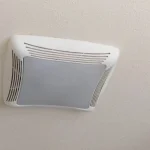A high-pitched noise coming from your bathroom fan, even when it’s off, can be more than just an annoyance. It may indicate an underlying issue that requires attention. Addressing this noise promptly is crucial, as it can prevent further damage to your fan and improve the overall functionality of your bathroom ventilation system.
In this article, we will explore the common causes of a high-pitched noise when your bathroom fan is off, provide practical DIY solutions, explain when it’s time to call a professional, and offer tips to prevent future issues.
Let’s start by understanding the possible reasons behind this unusual sound.
Causes of High-Pitched Noise When the Bathroom Fan Is Off
A bathroom fan making a high-pitched noise when turned off can result from various mechanical and environmental factors. Each issue may signal a different problem within the fan unit or the ventilation system. Let’s delve into the most common causes and explain why these might be contributing to the noise.
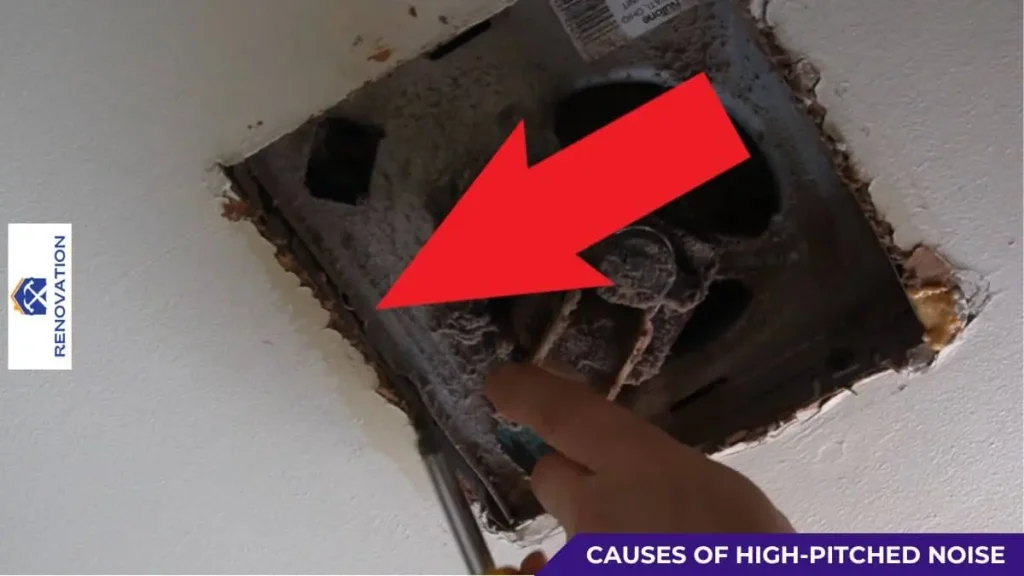
Airflow Obstruction in the Ventilation Duct
One of the primary causes of a high-pitched noise is airflow obstruction in the ventilation duct. Even when the fan is off, external airflow from wind or pressure changes can cause the blades to spin slightly. If there is a blockage in the duct, such as debris or accumulated dust, it can create turbulence. This results in a whistling or squeaking noise that often resembles a high-pitched sound.
The obstruction can come from common sources like bird nests, leaves, or dirt that may have entered the ductwork. This issue can disrupt the smooth passage of air, leading to unusual noises when the airflow pushes through small gaps or around obstacles.
Worn-Out Bearings
Another potential reason for the high-pitched noise is worn-out bearings in the fan motor. Over time, the motor’s bearings can wear down due to constant use, leading to friction between the moving parts. This friction can generate a high-pitched squealing or whining sound, which may persist even after the fan is switched off because of the residual motion in the motor components.
Worn bearings are common in older fans or units that haven’t been properly maintained. When the lubrication wears off, the metal parts grind together, creating the sharp sound you hear. This problem will likely worsen over time unless addressed.
Loose Fan Components
Loose components in the fan assembly can also cause high-pitched noises when the fan is off. If any part of the fan, such as screws, mounts, or the blades themselves, becomes loose, it can vibrate or shift slightly when air moves through the vent or when the fan slows down after being turned off. This movement can cause metal-on-metal contact, producing a sharp, piercing noise.
The problem is more common in fans that have been in use for an extended period without regular tightening or maintenance. Even a minor movement in the parts can create a significant noise, especially as the fan cools down.
Electrical Issues
While less common, electrical issues can sometimes lead to strange noises, including high-pitched sounds. If the fan is not properly grounded or if there is a short in the wiring, it could create a noise even when the fan is off. Electrical problems can also cause the fan motor to behave unpredictably, leading to sporadic movements or vibrations that produce noise.
Electrical issues are typically more dangerous, as they pose a risk of fire or electric shock if left unattended. If an electrical malfunction is suspected, it is crucial to address it immediately to ensure safety.
Backdraft Damper Malfunction
The backdraft damper is an important component of the bathroom ventilation system, designed to prevent outside air from entering the bathroom through the vent. If this damper becomes stuck, damaged, or misaligned, it can cause a whistling or high-pitched noise as air tries to push through it. This sound often occurs when wind or air pressure changes outside forcing the damper to move, even when the fan is off.
A malfunctioning backdraft damper can also allow cold air to enter the bathroom, reducing the overall efficiency of your ventilation system and contributing to potential moisture problems in your home.
Debris or Dust in the Fan Blades
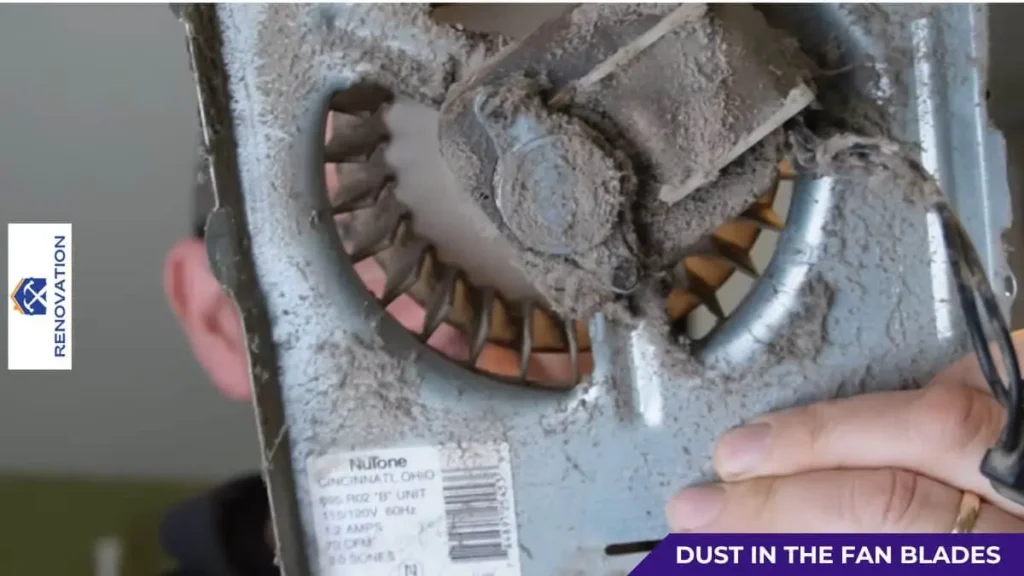
Debris or dust buildup in the fan blades can also be a source of high-pitched noise. Over time, dust and small particles can accumulate on the fan blades and motor components, creating an imbalance in the fan’s rotation. Even when the fan is off, residual movement in the blades can cause them to rub against this debris, producing a squeaking or whining sound.
In homes where bathroom fans are used frequently without regular cleaning, this problem can worsen. A layer of dust thick enough to interfere with the fan’s rotation can lead to long-term performance issues and increased noise levels.
Possible Solutions for a Noisy Bathroom Fan
Once you’ve identified the cause of the high-pitched noise coming from your bathroom fan, it’s time to explore the appropriate solutions. The following fixes address common issues such as airflow obstruction, worn-out bearings, and loose components. Implementing these solutions can help restore quiet operation and prolong the lifespan of your fan.
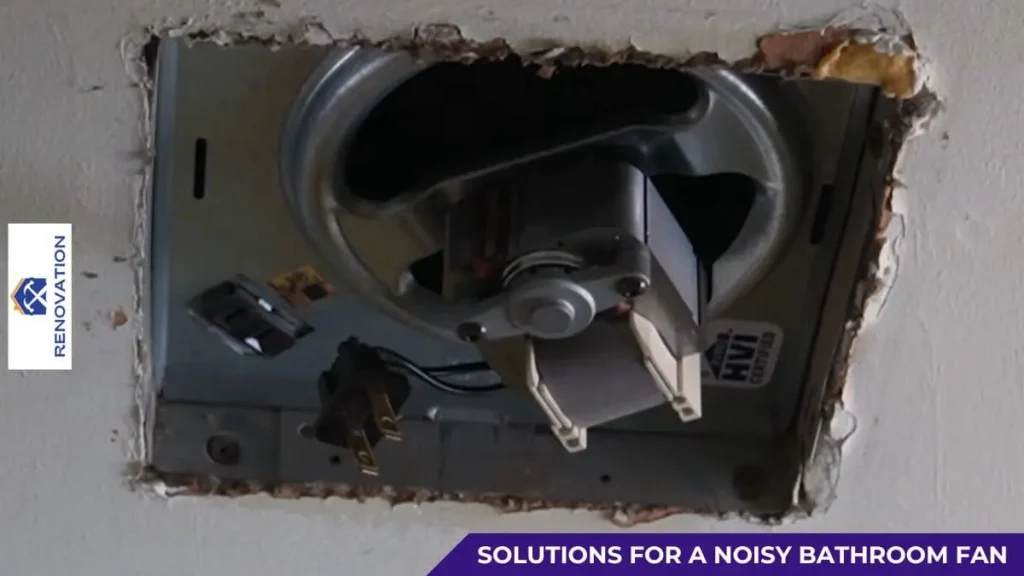
Clear Any Airflow Obstruction
If the noise is due to an obstruction in the ventilation duct, the first step is to clear the blockage. Inspect the exterior vent cap for any debris, such as leaves, dirt, or bird nests. Use a vacuum with a long attachment or a soft brush to remove any buildup that may be causing restricted airflow.
You may also need to check the ducting inside your home. Disconnect the fan unit from the duct if necessary, and inspect the duct for any internal blockages. If you find excessive dust buildup, a duct cleaning brush can help clear the passage. This simple cleaning can significantly reduce the noise caused by turbulent airflow in a blocked duct.
Lubricate or Replace the Bearings
If worn-out bearings are causing the noise, applying lubrication can temporarily reduce the friction causing the sound. Use a high-quality machine oil or bearing lubricant, which you can apply directly to the fan motor’s moving parts. This solution can stop the squealing noise by allowing the components to move smoothly.
However, lubrication is often a short-term fix. If the bearings are severely worn, the only permanent solution is to replace them. You may need to remove the fan unit to access the motor and swap out the old bearings for new ones. This process requires some technical knowledge, so if you’re not comfortable with fan motor repairs, it may be better to hire a professional.
Tighten Loose Components

Loose fan components, such as screws or mounts, can be tightened to stop vibrations that cause high-pitched noises. Turn off the power to the fan, and remove the fan cover to inspect for any loose parts. Use a screwdriver to tighten any screws that hold the fan housing or motor in place.
In some cases, you may need to inspect the fan blades themselves. Ensure that the blades are securely fastened to the motor and that they do not wobble during rotation. Tightening these parts will eliminate any movement that could create noise due to metal-on-metal contact or vibrations.
Address Electrical Issues
If electrical issues are behind the noise, it’s essential to address them immediately for both safety and functionality. Check the fan’s wiring for loose connections or frayed wires, which could be causing erratic behavior in the motor. Ensure that the fan is properly grounded, as improper grounding can lead to unpredictable movement or noise.
For more complex electrical issues, such as a malfunctioning motor or a short circuit, it’s recommended to consult a licensed electrician. Electrical repairs can be dangerous if not handled properly, so leave this to the professionals to ensure your fan operates safely and quietly.
Fix or Replace the Backdraft Damper
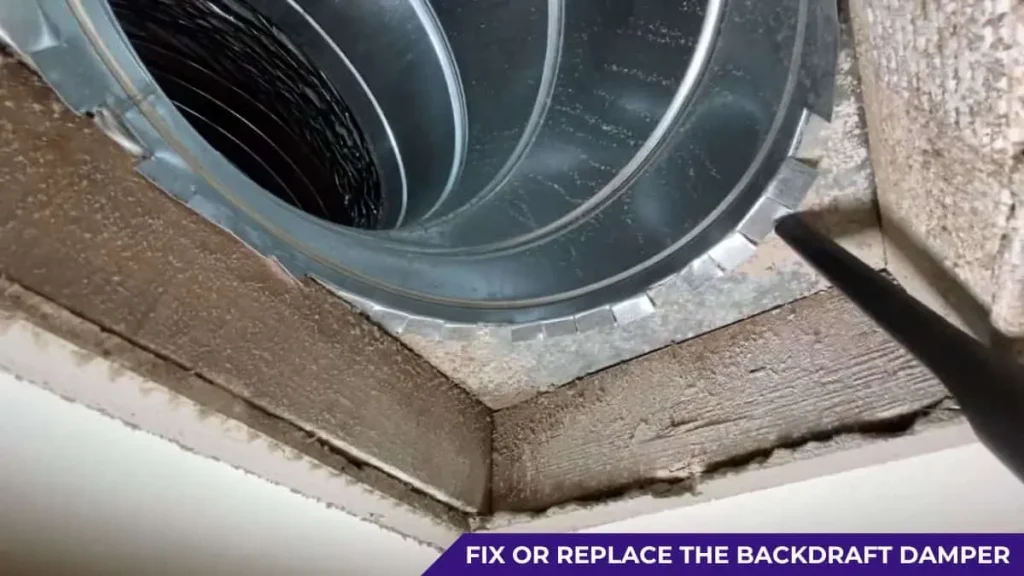
If the backdraft damper is malfunctioning and causing high-pitched noises, you may need to adjust or replace it. Inspect the damper to ensure it is moving freely and not stuck in one position. If it is obstructed or misaligned, clear the obstruction and realign the damper so it can open and close properly.
In some cases, the damper itself may be damaged or warped, preventing it from sealing correctly. Replace the damaged damper with a new one to restore its function. A properly functioning backdraft damper will prevent outside air from entering your home and eliminate any noise caused by its improper operation.
Clean the Fan Blades and Motor
Debris or dust buildup on the fan blades can be addressed with regular cleaning. Turn off the power to the fan, remove the cover, and gently clean the blades with a damp cloth to remove dust and grime. For more stubborn buildup, use a mild detergent.
You may also need to clean the motor components if dust has accumulated inside the unit. Use compressed air to blow out any dust from the motor housing, being careful not to dislodge any electrical connections. Keeping the fan clean will reduce the chance of imbalances in the blades, which can lead to unwanted noise.
DIY Fixes for Reducing Bathroom Fan Noise
If you’re experiencing a high-pitched noise from your bathroom fan, several do-it-yourself (DIY) solutions can help you reduce or eliminate the sound. Many of these fixes are straightforward and require basic tools and materials, making them accessible to most homeowners.

Cleaning the Fan and Ducts
One of the simplest DIY fixes for reducing noise in a bathroom fan is to clean both the fan and the ducts. Dirt, dust, and debris can accumulate on the fan blades and inside the duct, leading to airflow obstructions and unwanted sounds. To clean the fan, start by turning off the power to avoid any risk of electrical shock. Once the power is off, remove the fan cover by loosening the screws or unclipping it, depending on your model.
Gently clean the fan blades with a damp cloth to remove any dust. If you notice any stubborn grime, you can use a mild detergent to wipe it off. Cleaning the blades will not only reduce noise but also improve the overall efficiency of the fan. After cleaning the blades, inspect the inside of the duct for any blockages. You can use a vacuum with a hose attachment to remove dust and debris, ensuring that airflow is not restricted.
Finally, replace the fan cover securely and turn the power back on. This simple cleaning procedure can significantly reduce noise, especially if the sound is caused by airflow resistance or dust buildup.
Tightening Loose Components
Another effective DIY fix for reducing bathroom fan noise is tightening any loose components. Over time, screws and mounting brackets may loosen due to the constant vibration of the fan. This can result in rattling or high-pitched noises. To address this issue, turn off the power and remove the fan cover.
Check all the screws that secure the fan housing to the ceiling or wall and use a screwdriver to tighten them if needed. Pay particular attention to the screws that hold the motor and fan blades in place, as these are often the main culprits behind noisy operation. Make sure the fan blades are securely fastened to the motor and do not wobble during rotation.
If the fan has a backdraft damper, inspect it as well to ensure that it is not loose or misaligned. Tightening these components will eliminate movement that leads to noise caused by vibration or metal-on-metal contact.
Lubricating the Fan Motor
In some cases, a high-pitched noise may be the result of friction within the fan motor’s bearings. Lubricating the motor is a simple DIY solution that can help reduce this type of noise. To do this, first turn off the power and remove the fan cover. Then, locate the motor’s bearings, which are typically near the center of the fan unit.
Use a high-quality machine oil or bearing lubricant to apply a few drops to the bearings. Be careful not to over-lubricate, as this can cause other issues with the motor. Once the bearings are lubricated, reassemble the fan and turn the power back on. This lubrication process can reduce friction and help the fan run more smoothly, which in turn reduces noise.
Replacing the Fan Motor

If lubrication does not solve the problem, it may be necessary to replace the fan motor entirely. Replacing a worn-out motor is a more advanced DIY fix, but it can be done with some technical knowledge and the right tools. Begin by turning off the power and removing the fan cover and motor housing. Once the motor is exposed, disconnect the wiring that powers the fan.
Remove the motor from the housing and replace it with a new one of the same specifications. Reconnect the wiring and reassemble the fan unit, ensuring that all screws are tightened securely. Replacing the motor can eliminate high-pitched noises caused by worn-out bearings or other internal motor issues.
Insulating the Fan Housing
Another DIY method to reduce bathroom fan noise is to add insulation around the fan housing. Many bathroom fans are installed directly into the ceiling without any soundproofing materials, which can lead to amplified noise. To insulate the fan, first turn off the power and remove the fan cover.
Once the cover is removed, you can apply soundproofing material, such as acoustic foam or soundproof insulation, around the edges of the fan housing. Be careful not to obstruct the fan blades or motor when applying the insulation. This added layer of soundproofing will help absorb the vibrations and reduce noise transmission into the surrounding area.
After the insulation is installed, replace the fan cover and turn the power back on. This simple step can make a noticeable difference in reducing both high-pitched noises and general fan operation sounds.
Adjusting or Replacing the Backdraft Damper
If you suspect that the high-pitched noise is coming from the backdraft damper, adjusting or replacing it can be an effective DIY fix. The damper is responsible for preventing outside air from flowing back into the bathroom, but if it becomes stuck or damaged, it can create noise. Start by turning off the power and removing the fan cover to access the damper.
Check the damper to ensure that it opens and closes freely. If it is stuck or misaligned, gently adjust it until it moves properly. If the damper is damaged, you may need to replace it. Replacing the damper involves removing the old one and installing a new unit of the same size and type.
Once the damper is working correctly, replace the fan cover and turn the power back on. A properly functioning damper will not only reduce noise but also improve the overall efficiency of your bathroom fan.
Recommended Post: How to Vent Multiple Bathroom Exhaust Fans
How to Prevent Future Bathroom Fan Noises
Addressing the cause of your bathroom fan’s noise is an important first step, but ensuring that the noise doesn’t return requires taking preventive measures. By maintaining the fan properly, upgrading its components, and making adjustments to how it’s installed, you can prevent future high-pitched or disruptive noises. Below are some practical ways to keep your bathroom fan running quietly over the long term.
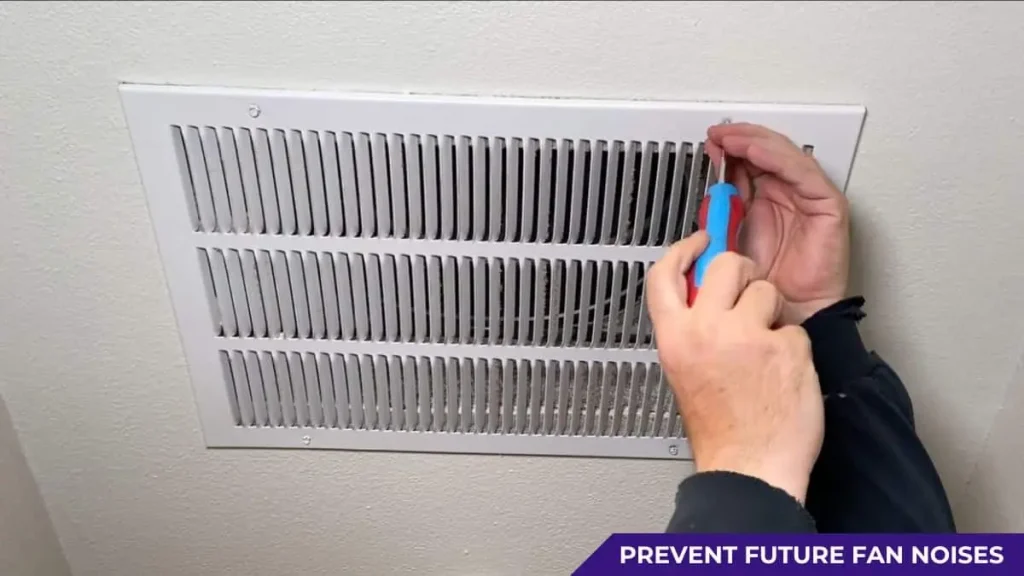
Regular Maintenance
The most effective way to prevent future bathroom fan noises is through regular maintenance. Over time, dust and debris can accumulate inside the fan housing, the blades, and the ductwork, which can lead to noisy operation. By establishing a maintenance routine, you can avoid these issues before they become problematic.
Cleaning the fan blades and housing every three to six months is recommended. Turn off the power, remove the fan cover, and use a damp cloth to wipe away any dust or buildup. Be sure to clean the ducts as well by using a vacuum with a hose attachment to clear out any obstructions. If the fan has a filter, check it regularly and replace it as needed.
In addition to cleaning, periodically check the screws and mounting brackets to ensure that they remain tight and secure. Loose components are a common cause of fan noise, and addressing them early can prevent rattling and other unwanted sounds.
Lubricating Moving Parts
As part of your maintenance routine, it’s important to keep the fan motor’s moving parts properly lubricated. A lack of lubrication can cause the motor’s bearings to wear out over time, leading to friction and noise. By applying high-quality machine oil to the motor bearings every six to twelve months, you can prevent this issue and extend the life of your fan.
To lubricate the motor, turn off the power and remove the fan cover. Locate the motor bearings and apply a few drops of oil to keep them moving smoothly. Be careful not to over-lubricate, as this can cause oil to drip onto other components. Proper lubrication reduces wear and tear on the motor and helps maintain quiet operation.
Upgrading to a Quieter Model
If your current bathroom fan is old or noisy despite regular maintenance, upgrading to a quieter model may be the best long-term solution. Modern fans are designed to operate more efficiently and with significantly reduced noise levels. Look for fans with a low sone rating, which indicates the sound level produced during operation. A sone rating of 1.0 or lower is considered very quiet, while ratings higher than that may produce noticeable noise.
When selecting a new fan, also consider the CFM (cubic feet per minute) rating, which indicates how much air the fan can move. Ensure that the fan you choose is powerful enough to ventilate your bathroom properly, as an undersized fan will have to work harder, potentially generating more noise.
Installing a new, quieter fan can drastically reduce future noise issues while also improving the overall efficiency of your bathroom’s ventilation system.
Installing Soundproofing Materials
Another effective way to prevent future noise from your bathroom fan is by installing soundproofing materials around the fan housing. If your fan is mounted directly onto the ceiling or wall without any insulation, the vibrations from the fan’s motor can resonate through the surrounding structure, amplifying the noise. By adding soundproofing materials, you can absorb these vibrations and reduce noise.
Acoustic foam, rubber gaskets, or soundproofing insulation can be installed around the edges of the fan housing to dampen vibrations. When applying these materials, be careful not to obstruct the fan blades or airflow. Proper soundproofing will not only prevent future noise but also create a quieter environment overall.
Related Read: How to Vent a Bathroom Fan Through Roof
Ensuring Proper Installation
Incorrect installation is often the root cause of bathroom fan noise. Whether the fan was improperly mounted or the ductwork was not secured correctly, these installation errors can lead to rattling, buzzing, or high-pitched noises. Ensuring that the fan is installed correctly in the first place is key to preventing future noise issues.
If you are installing a new fan or making adjustments to an existing one, follow the manufacturer’s installation instructions carefully. Make sure the fan is securely mounted to the ceiling joists or wall studs, and that the screws and brackets are tightened properly. Additionally, ensure that the ductwork is free from kinks or sharp bends, as these can restrict airflow and cause the fan to work harder, generating more noise.
For optimal performance, the ductwork should be insulated to prevent condensation buildup and to reduce noise caused by airflow resistance. Using flexible ducts can also help minimize vibrations and noise.
Using a Backdraft Damper
To prevent noise from airflow or outside elements, consider installing a backdraft damper in your duct system. This component helps to prevent air from flowing back into the bathroom when the fan is not in use. A malfunctioning or absent damper can lead to airflow-related noises such as whistling or a high-pitched sound.
If your fan already has a damper installed, make sure it is functioning properly by inspecting it periodically. The damper should open and close easily without getting stuck or misaligned. If the damper is damaged or missing, replacing it can help eliminate these airflow-related noises and prevent future sound issues.
Avoiding Overuse
Lastly, another simple but effective way to prevent future bathroom fan noises is by avoiding overuse. Bathroom fans are designed for intermittent use, such as during showers or while airing out the bathroom after use. Running the fan continuously for extended periods can cause wear and tear on the motor, leading to premature damage and noise.
Use the fan only when necessary, and turn it off once the moisture has cleared from the bathroom. If your bathroom requires continuous ventilation, consider installing a fan with a built-in timer or humidity sensor, which will automatically turn the fan off after a set period or when moisture levels have decreased.
Preventing future bathroom fan noise requires a combination of regular maintenance, proper installation, and thoughtful use.
Read Also: How to Replace a Bathroom Light with a Fan Light Combo
Conclusion
A noisy bathroom fan can be more than just an annoyance; it can indicate underlying issues that, if left unchecked, may lead to bigger problems. Understanding the causes behind the high-pitched noise when the fan is off, such as faulty motor components or improper airflow, allows you to address the problem effectively. Whether it’s cleaning, tightening screws, or replacing parts, there are various DIY fixes and professional solutions available to restore quiet operation.
Prevention is key to avoiding future noise problems. Regular maintenance, proper installation, and thoughtful upgrades can ensure that your bathroom fan runs smoothly for years without disrupting your peace.

